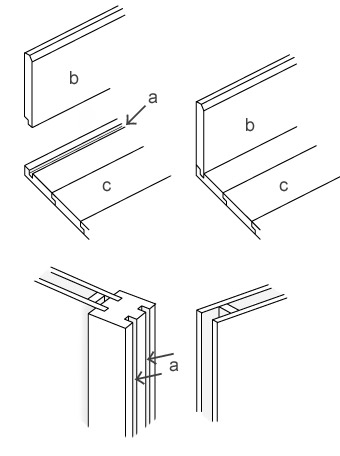|
||
 |
||

a) koana 小穴 b) habaki 幅木 c) yuka-ita 床板
(C)2001 Japanese Architecture and Art Net Users System. No reproduction or republication without written permission.
掲載のテキスト・写真・イラストなど、全てのコンテンツの無断複製・転載を禁じます。
|
||||||
| koana 小穴 | ||||||
| KEY WORD : architecture / general terms | ||||||
| A shallow, narrow groove cut into a pillar, flooring board or other structural element to allow for a secure junction with other members. This operation utilizes a type of angle called *shiguchi 仕口. The board to be inserted has a right angle piece cut out of it, similar to a shiplap joint *aijakuri 合决 except in this case the extending part is set into a groove in an upright position rather than broadside down as flooring boards would be. Several expressions are used to refer to the actual boring of the narrow groove: koana-ni-shiguchi 小穴に仕口, which means to join the member by placing it at right angles into the narrow groove; koana-ni-ire 小穴に入れ has the same meaning; and koana-ni-tsuki 小穴に突き, means to bore a narrow groove. When a koana is used for a plastered wall, it is called chirijakuri 散决. | ||||||
 a) koana 小穴 b) habaki 幅木 c) yuka-ita 床板 |
||||||
| REFERENCES: | ||||||
| EXTERNAL LINKS: | ||||||
| NOTES: | ||||||
(C)2001 Japanese Architecture and Art Net Users System. No reproduction or republication without written permission. 掲載のテキスト・写真・イラストなど、全てのコンテンツの無断複製・転載を禁じます。 |
||||||